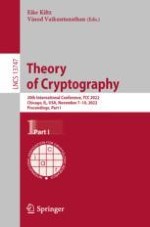2022 | OriginalPaper | Buchkapitel
Collusion Resistant Copy-Protection for Watermarkable Functionalities
verfasst von : Jiahui Liu, Qipeng Liu, Luowen Qian, Mark Zhandry
Erschienen in: Theory of Cryptography
Verlag: Springer Nature Switzerland
Aktivieren Sie unsere intelligente Suche, um passende Fachinhalte oder Patente zu finden.
Wählen Sie Textabschnitte aus um mit Künstlicher Intelligenz passenden Patente zu finden. powered by
Markieren Sie Textabschnitte, um KI-gestützt weitere passende Inhalte zu finden. powered by
Abstract
-
The feasibility of copy-protecting all watermarkable functionalities is an open question raised by Aaronson et al. (CRYPTO’ 21). In the literature, watermarking decryption, digital signature schemes and PRFs have been extensively studied. For the first time, we show that digital signature schemes can be copy-protected. Together with the previous work on copy-protection of decryption and PRFs by Coladangelo et al. (CRYPTO’ 21), it suggests that many watermarkable functionalities can be copy-protected, partially answering the above open question by Aaronson et al.
-
We make all the above schemes (copy-protection of decryption, digital signatures and PRFs) k bounded collusion resistant for any polynomial k, giving the first bounded collusion resistant copy-protection for various functionalities in the plain model.
